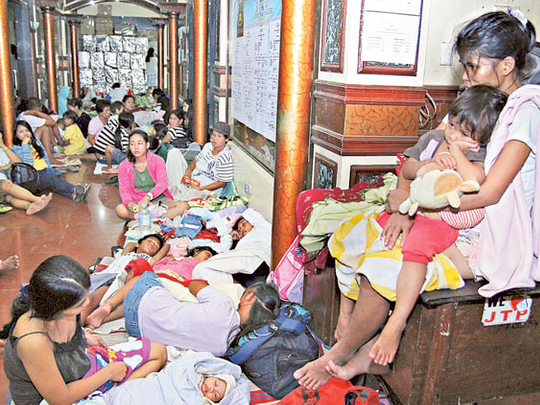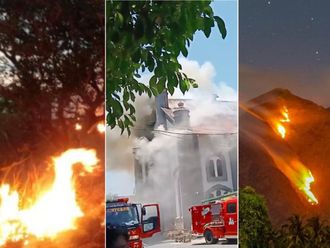
Manila: Thousands of people on the Philippines’ Pacific coast returned to their homes on Saturday after fleeing in terror when a major offshore earthquake triggered a tsunami warning.
A 44-year-old woman was killed while a boy, aged five,was injured following the powerful 7.7 magnitude quake that struck Central Philippines on Friday evening.
Benito Ramos, director of the National Disaster Risk Reduction and Management Council (NDRRMC) said effects of the temblor was felt as far away as Northern Mindanao causing a landslide in the village of Lapasan in Cagayan de Oro City.
Lapasan experienced an intensity 3 earthquake, mild compared to that felt at the earthquake’s origin in Eastern Samar and Surigao del Norte, but powerful enough to cause a landslide that buried the house of Elenita Ubalde who died, and caused injuries to her grandson Adrian Rosales.
Most of the residents had fled the east coast by the time waves of up to half a metre (20 inches) hit coastal areas within an hour of the 7.6-magnitude temblor striking offshore late Friday, civil defence chief Benito Ramos said.
“They feared they would be swamped by waves as large as those in the [March 2011] Japan tsunami, so it was not difficult to convince them to leave,” he said.
“Most of them returned home after the tsunami alert was lifted just after midnight (1600 GMT Friday), although about 50 families remained at evacuation centres, fearing a tsunami could still strike.”
The NDRRMC said that other incidents related to the earthquake include a fire in Agusan del Sur’s Bunawan town, which was caused by a gas lamp that was toppled by the temblor. Bridges in Eastern Samar also sustained damages from the quake.
Earlier, authorities had ordered evacuation of residents on the coast of Eastern Samar areas, particularly Guiuan town amid fears of a tsunami. The tectonic quake struck at 8.47pm on Friday some 112 kilometres south, 78 degrees east of Guiuan.
The earthquake wasthe strongest that struck the country this year. Its aftershocks continue to be felt until Saturday afternoon.
Tsunami warning
The Philippine Institute of Volcanology and Seismology (Phivolcs) had lifted a tsunami warning it issued moments after the earthquake struck by 12am Saturday.
Phivolcs earlier issued tsunami alert level 3 which sought immediate evacuation of people in several Visayas and Mindanao coastal areas facing the Pacific Ocean.
“All tsunami alerts are now lifted,” Philippine Institute of Volcanology and Seismology (Phivolcs) said in its 12.10am September 1Tsunami Bulletin.
“Initial reports of sea level disturbance received by Phivolcs indicate that the tsunami generated by this earthquake did not reach life-threatening heights. The National Mapping and Resource Information Authority (NAMRIA) reported the tsunami in Surigao City with initial heights of 16 centimetres and 19 centimetres at 10.48pm. The Pacific Tsunami Warning Center (PTWC) also reported a three centimetre tsunami recorded by the tide gauges in Legaspi City at 9.43pm and Davao City at 9.50pm. Waves not higher than half a metre were also reportedly observed in Pilar, Surigao del Norte in Siargao Island about 10 minutes after the earthquake. No bigger tsunami associated with this earthquake is expected to follow after this cancellation.”
Aside from the Visayas and Mindanao islands, the earthquake was felt in Bicol.
Disaster management services including the coast guard and the military were alerted on Friday evening for possible mobilisation for rehabilitation and evacuation efforts.













